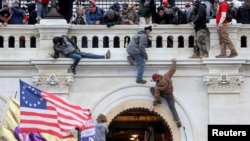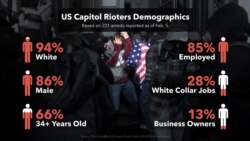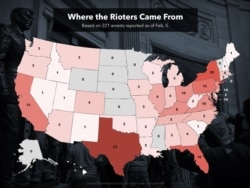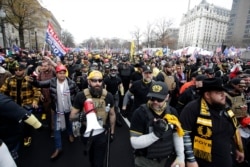When former President Donald Trump urged his followers last month to come to Washington to stop Congress' certification of Democratic rival Joe Biden's presidential victory, tens of thousands heeded his call.
After hearing rousing speeches by Trump and his allies, thousands then marched on the nearby U.S. Capitol. An estimated 800 stormed the building in a melee shocking in its intensity and sustained violence, which left five people dead, including a police officer, and scores of others injured.
While Trump is standing trial in the Senate this week on a single impeachment charge of inciting the mob on January 6, more than 200 ardent Trump supporters who took part in the Capitol breach have been arrested and face a variety of charges in federal court in Washington.
Who were the rioters? And what motivated them to attack the seat of their own government?
Initially, they appeared to be mostly "knuckleheads," said Seamus Hughes, deputy director of The George Washington University Program on Extremism.
Then, the FBI started arresting key members of the pro-Trump Proud Boys and two militia groups, training the spotlight on far-right organizations.
Now, nearly five weeks after the attack, researchers at the University of Chicago have concluded that the majority of the rioters were not members of far-right groups but "normal" Trump supporters — part of his political base. Among them were doctors, lawyers, architects and business owners.
"What we are dealing with here is not merely a mix of right-wing organizations, but a broader mass movement with violence at its core," Robert Pape and Keven Ruby of the Chicago Project on Security and Threats (CPOST) wrote in a recent report.
The videotaped recordings of the rioting presented this week by the House managers prosecuting the case against Trump revealed shocking images of hate-filled Americans storming the Capitol, some of them armed with guns, chemical mace, hammers, flag-draped poles and lances, and seemingly bent on finding and killing high-ranking government officials, including then-Vice President Mike Pence and House Speaker Nancy Pelosi.
All of them had been egged on by Trump to march on the Capitol and "fight like hell" to prevent Congress from certifying Biden's Electoral College victory, which Trump for weeks had falsely called a fraud.
Understanding who the rioters are is key to developing tools to confront this new movement, Pape and Ruby said. Left unchecked, "the movement may well grow," they warned.
To counteract this troubling development, what is needed is "de-escalation approaches for anger among large swaths of mainstream society," the researchers said.
Other researchers following the rioters have reached similar conclusions. Hughes said he agreed they represent a new mass movement of violent extremism. But he said a repeat of January 6 is unlikely, given that the "merely curious" types that took part in the insurrection would be reluctant to participate again.
"No one's going in there ignoring the law," he said. "If somebody tried to do something like that again, they're going in there fully aware of what they're about to do."
The University of Chicago report was last updated on February 5 and doesn’t include charges filed over the past week.
Extremism researcher Brian Levin, director of the Center for the Study of Hate and Extremism at California State University, San Bernardino, cautioned that the data on the rioters is far from conclusive, and as the investigation proceeds, previously unknown ties between the insurrectionists and organized right-wing groups may come to light.
Just because a violent rioter is not a member of an organized extremist group does not make him or her any less dangerous, Levin said.
"They might dine from the same buffet table of extremism," but "you don't have to be a member of the Proud Boys or the Oath Keepers to belong to the same overall subculture or to adhere to certain conspiracies," he said.
Demographic snapshot
To gain insight into the backgrounds and ideologies of the rioters, the University of Chicago researchers examined more than 1,500 court documents and media stories about 221 people arrested so far.
They found that in contrast to right-wing extremists arrested over the past five years, the Capitol rioters make up an older, better employed crowd.
The majority are white and male. Sixty-six percent are 34 years or older; 85% have jobs; 13% are business owners, while 27% hold white-collar jobs.
Geographically, they hail from across the country and not just from "red" counties that support Trump. In fact, more than half come from counties that Trump lost to Biden — counties that tend to be more racially mixed with higher unemployment rates, according to the report.
"This will come as a surprise to many Biden supporters, who presumably think that the insurrectionists are coming from red counties — rural, almost completely white, and with high unemployment — far from Biden strongholds," the researchers said.
'Normal' Trump supporters
Of the 221 defendants the researchers investigated, 198 had no known links to militias or other far-right groups. That is about 90% of the total. The researchers characterize these unaffiliated rioters as "normal" pro-Trump activists.
Hughes said the majority of these rioters fall under what he calls the "merely curious" category — "folks taking selfies in the Senate Rotunda."
Former Houston police officer Tam Pham claims to have been such a participant. Before his arrest last month, Pham told FBI agents he went into the Rotunda to look at "historical artwork on the walls."
Brad Rukstales, an Illinois business executive, said in a statement after his arrest along with five other rioters that he "followed hundreds of others through an open set of doors to the Capitol building to see what was taking place inside."
According to Hughes, some rioters came in husband-and-wife pairs, while others brought their sons and daughters into the Capitol. Texas father and son James and Chance Uptmore attended the Trump rally while on a five-day trip to celebrate Chance's birthday before breaking into the Capitol, they told investigators.
Chance said he "entered the Capitol building because he was caught up in the crowd, and because it was a once-in-a-lifetime event," according to court documents.
The rioters' ideologies run the gamut. What brought them together was a belief that the November election was "stolen" and they needed to "stop it," Hughes said.
Far-right affiliations
So far, 23 insurrectionists, or 10% of the total, have been linked to various far-right groups, according to the University of Chicago study.
Thirteen are alleged members of the Proud Boys, a far-right, pro-Trump group that describes itself as a "beer drinking club." On Thursday, five additional members of the Proud Boys were arrested in connection with the January 6 riot. Court documents show that the Proud Boys began planning for January 6 well in advance of the attack, with their leader, Enrique Tarrio, urging them to go "incognito."
Tarrio was arrested two days before the riot and was barred from returning to Washington. In the days since, two other prominent members of the group — organizer Joe Biggs, 37, and "Sergeant of Arms" Ethan Nordean, 30 — have been charged for their roles in the riot. Additional charges are likely forthcoming, Hughes said, noting that arrest warrants have been issued for a number of other members.
In addition to the Proud Boys, nine members of the Oath Keepers and the Three Percenters — two far-right militia groups — have been charged.
Last month, three suspected members of the Oath Keepers were indicted on multiple felony charges for coordinating their attack on the Capitol. The trio documented their movements during the riot.
"Yeah. We stormed the Capitol today. Teargassed, the whole, 9. Pushed our way into the Rotunda. Made it into the Senate even. The news is lying (even Fox) about the Historical Events we created today," Jessica Watkins, 38, an Oath Keeper and a self-styled commander of the Ohio State Regular Militia posted on social media.
The Oath Keepers and the Three Percenters are known for recruiting current and former military personnel, police officers and firefighters. According to the report, 40% of the militia members and other right-wing extremists arrested so far have military experience. Watkins is a veteran of the war in Afghanistan.
QAnon support
Among the most memorable images on January 6 were QAnon signs and other memorabilia carried by the rioters. But the University of Chicago researchers found that just 8% of those arrested so far — fewer than 20 people — have expressed support for the QAnon conspiracy theory. That largely mirrors the percentage of adults who say the conspiracy that Trump is secretly battling a cabal of Satan-worshipping pedophiles is at least "somewhat accurate."
Among the QAnon supporters charged is Jacob Chansley, the so-called "QAnon shaman" also known as Jake Angeli, who gained notoriety for storming the Capitol sporting horns, a bearskin headdress, and red, white and blue face paint. He told FBI agents he traveled to Washington with other "patriots" from Arizona at Trump's "request."
Other QAnon supporters have drawn less public attention. Henry Phillip Muntzer, an appliance store owner from Montana, is known locally for a QAnon mural covering the façade of his store front. In a Facebook post that included a video taken from inside the Capitol, Muntzer wrote, "Stormed the Capitol in Washington DC we were able to push through the capitalpPolice (sic) and enter several Chambers," according to court documents.















